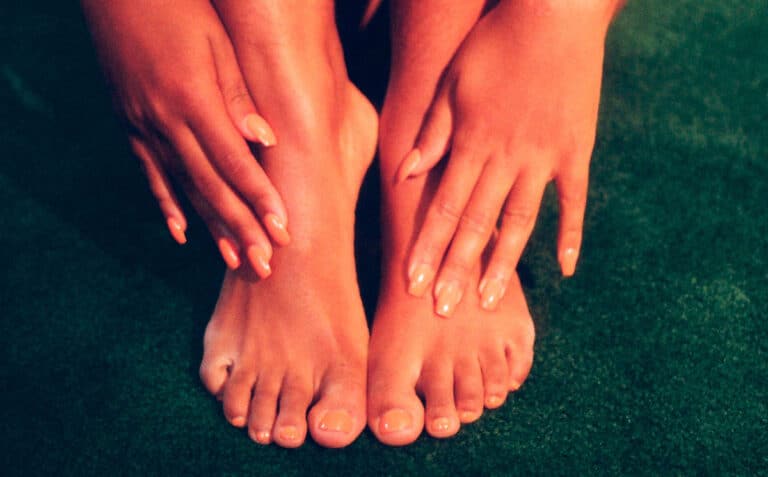There’s a scientific explanation behind your foot fetish
Foot fetishism is surprisingly common. Academic studies on the prevalence and membership of fetish discussion groups have found that feet and foot accessories are the most fetishised of all non-genital body parts and objects. According to Live Science, nearly half of all such fetishes focus on feet, and almost two-thirds of fetishes for objects associated with the body are for shoes and socks.
Although Sigmund Freud claimed that people sexualise feet because they resemble penises, it turned out he was wrong—not much of a surprise there. A recent, more objective, theory has appeared since then, but before we get into it, let’s have a quick look at what fetishes are exactly.
What is a foot fetish?
A fetish is a form of sexual desire in which gratification is linked to an abnormal degree to a particular object, item of clothing, part of the body, and more. A foot fetish, also known as podophilia, is where the feet, legs, stockings, shoes, or socks, are the cause of a person’s sexual arousal.
Although the terms ‘fetish’ and ‘kink’ are often used interchangeably, it is important to note that there are some key differences between the two, which lay in the psychology of a specific sexual desire. A kink applies to many different ‘alternative’ sexual interests, preferences, and/or fantasies. A fetish is specifically for body parts and their associated objects.
More often than not, a fetish will be psychologically ingrained in someone’s desires—for example, it becomes almost impossible for someone with a fetish to feel sexual pleasure without including this particular thing in their sex life.
Sometimes, a fetish is a kink that has become psychologically essential to sexual gratification. For some, participating in a specific BDSM activity may start as a fantasy and eventually lead to something they need in order to feel arousal, pleasure, and sexual release.
When it comes to foot fetishes nowadays, there is a big online market for people that are looking to purchase pictures of feet. The millions of people who have a foot fetish have turned to specific platforms to satisfy their needs and pay for pictures of feet that are tailored to their taste.
Different theories on why people have foot fetishes
The idea of how fetishes are formed has been a question of intrigue for a long time. As mentioned before, Freud was one of the first people to study fetishes-related behaviours. He believed that they arose during early childhood, and further suggested that when a male child saw their mother’s genitals, they were shocked to find that their mother did not have a penis, leading to a fixation on objects or body parts that looked like penises. In his mind, feet were seen as a ‘penis substitute’.
Another theory surrounding fetishism suggested that there are prerequisite personality traits that enable us to become more or less likely to develop certain fetishes. According to psychologist Doctor Justin Lehmiller, the idea that people are ‘born with’ fetishes likely won’t be proven—but there is merit to the idea people may be born with a generalised predisposition to developing fetishes.
“Although personality is undoubtedly influenced by environmental factors, several studies have suggested that a number of personality traits are heritable to some degree. So, to the extent that individuals are born with tendencies towards certain personality traits could explain why some people are more likely to develop fetishes than others,” Lehmiller explained to Big Think.
In his book titled Tell Me What You Want, the psychologist reported that one in seven people have reported having a foot-related sexual fantasy before. However, he added that the number of people who have a true fetish for feet is likely to be much smaller than that. Indeed, it’s important to note how just because someone has fantasised about feet in a sexual capacity doesn’t mean they have a fetish for feet.
Neuroscientist Vilayanur Ramachandran, director of the Center for Brain and Cognition (CBC) at the University of California, San Diego, has spent years studying and analysing the neural mechanisms that cause human behaviours. The results of a study he conducted on the clinical phenomenon known as “the phantom limb,” where people who have lost limbs continue to have vivid sensations (pain or otherwise) where the missing limb would be, have highlighted a new theory on why some people may have foot fetishes.
Chronic phantom pain is present in about two-thirds of patients who have had a limb removed. According to Ramachandran, every point on your body has a corresponding point in your brain. When someone loses a limb, the brain rewires the area of the brain that is connected to that specific part of your body and can often make it feel as though there is still a limb there. This is the explanation found in studies of phantom missing limb pains.
In one of Ramachandran’s studies, many people who had lost a foot also reported that they could experience sexual pleasure from thinking about their missing foot. While this may sound strange, a groundbreaking study from the late 1950s backs this new theory.
At the time, American-Canadian neurosurgeon Wilder Graves Penfield established the “body image map” (also referred to as “The Penfield homunculus”), which found that sensations in the body directly correlated to stimulations in various parts of our brain. The sensory perception for our feet is located directly adjacent to the sensory perception area for our genitalia—perfectly explaining the normalcy behind foot fetishism.
Yet, until now, no one else had put two and two together and realised that foot fetishes could possibly result from cross-wiring in the brain between the foot and the genital parts. Due to the complexities of sexual psychology—at least, that’s what I like to assume—there is still very little research available on the subject.
Sometimes, it’s just difficult to fully explain why our brain reacts the way it does to certain stimulation. And as Ramachandran wrote in Phantoms in the Brain: Probing the Mysteries of the Human Mind, “Maybe even many of us so-called normal people have a bit of cross-wiring, which would explain why we like to have our toes sucked.”






